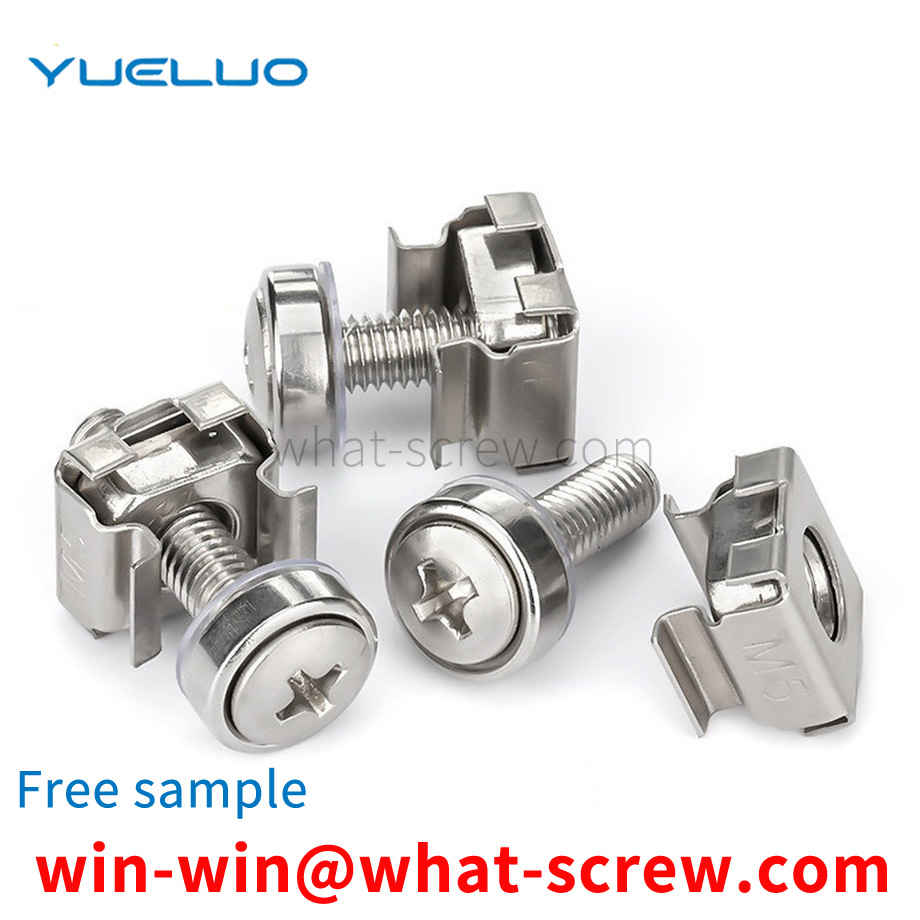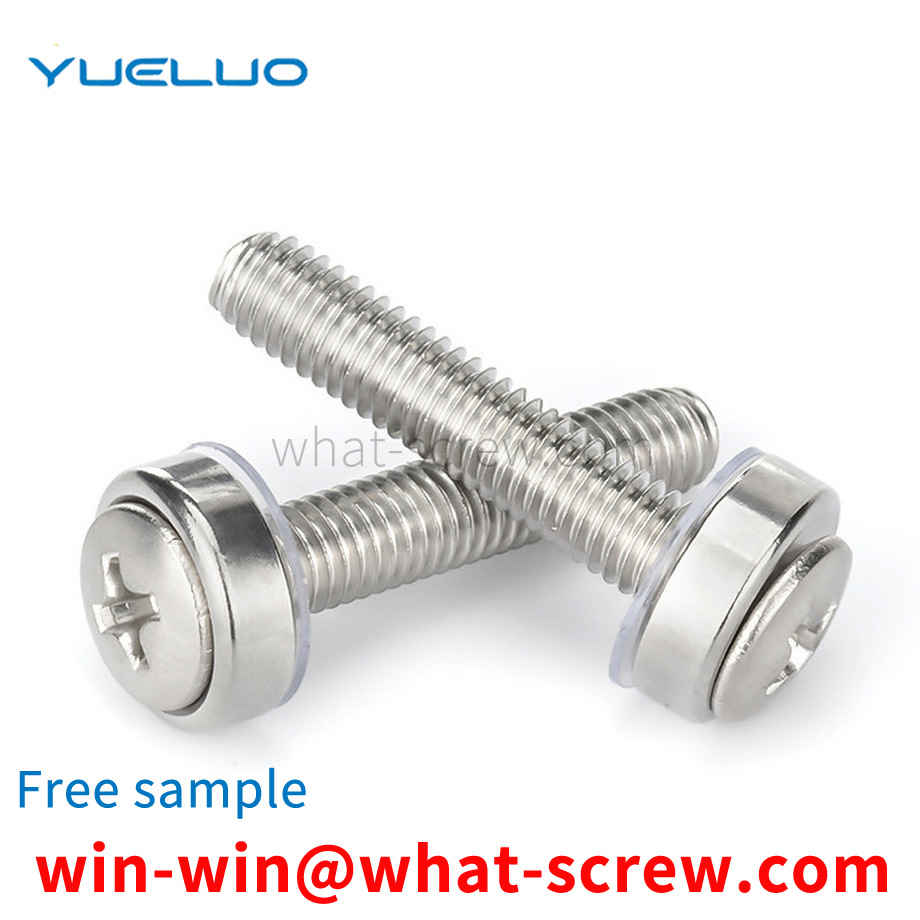Swimming self-locking nut GJB 125.1~125.6-86 The double-ear sealing swimming self-locking nut is composed of four parts: sealing cover, self-locking nut, pressure ring and sealing ring. It has compact structure and reliable sealing, and is suitable for products whose working pressure is not more than 2atm, working medium is gasoline, kerosene, water or air, and the operating temperature is -50~100℃. However, it has certain difficulties in the manufacturing process and air tightness test.
The square nut is a fastener that needs to be used in the installation of the cable tray. In the prior art, the square nut 1 is pressed by the elastic force of the spring 2 below it and the opening of the C-shaped steel 3 (as shown in Figure 1, Figure 2), in the absence of external force, through the interaction of pressure and static friction, the C-shaped steel 3 will not move vertically or horizontally, which can facilitate engineering installation. The advantage of this installation method is that it can slide anywhere on the C-shaped steel 3, but the disadvantage is that it occupies the bottom space of the C-shaped steel 3, and the spring 2 will interfere with the installation hole of the square nut I, which affects the installation.
Screw name broadcast 1. Machine screw 2. Self-tapping screw 3. Drilling screw 4. Wallboard screw 5. Fiberboard screw 6. Wood screw 7. Hexagonal wood screw 8. Non-prolapse screw 9. Combination screw 10. Micro screw 11. Furniture screws 12. Electronic screws
1. For low strength (below 500 N/mm2 or below 60000 psi) bolts use general soft steel, generally use SAE 1008 or JIS SWRM 8 (or SWRCH 8). 2. Lower strength (600 N/mm2 or 74000 psi) ) bolts use general soft steel, but limited carbon content grade, generally use SAE 1010 - 1015 or JIS SWRM 10 - 15 (or SWRCH 10 - 15). .3. Higher strength ( 800 N/mm2 or 125000 psi ) bolts of medium carbon steel, low carbon boron steel plus quenching and tempering, generally use SAE 1035 - 1040 or SWRCH 35K - 40K. 4. High strength (900 N/mm2 or more or 150000 psi or more) bolts use medium carbon Alloy steel or low carbon boron steel, in terms of application, if the metric Class 10.9 uses low carbon boron steel, the imprint should be added under the series imprint to become 10.9, and the imprint of the inch 8.2 grade is also used with the general Grade 8 bolts The imprint is different for easy identification. High-strength bolts made of low carbon boron steel cannot be used in high temperature conditions. The design strength exceeds Class 12.9 or ASTM A574 ultra-high strength bolts are limited to medium carbon alloy steel plus quenching and tempering. The performance grades of bolts for steel structure connection are divided into more than 10 grades such as 3.6, 4.6, 4.8, 5.6, 6.8, 8.8, 9.8, 10.9, 12.9, etc. Among them, the bolts of grade 8.8 and above are made of low-carbon alloy steel or medium-carbon steel and are heat-treated (quenching, tempering), commonly known as high-strength bolts, the rest are commonly known as ordinary bolts. The bolt performance grade label consists of two parts of numbers, which represent the nominal tensile strength value and yield ratio of the bolt material respectively. For example, a bolt with a performance level of 4.6 means: 1. The nominal tensile strength of the bolt material is 400MPa; 2. The yield ratio of the bolt material is 0.6; 3. The nominal yield strength of the bolt material is 400×0.6=240Mpa . Performance level 10.9 high-strength bolts, after heat treatment, can achieve: 1. The nominal tensile strength of the bolt material is 1000MPa; 2. The yield ratio of the bolt material is 0.9; High-strength bolts, processing and manufacturing problems are compared Small, general fastener manufacturing companies can master the manufacturing process; but problems are prone to occur in material selection and heat treatment. Material selection is the primary link. Various alloying elements have a great influence on the properties of the material, and the material must be subjected to spectral composition analysis; secondly, the fracture problem and the choice of heat treatment process have a great influence and are very important. Dealers and traders must control the inspection and performance testing links; automotive fasteners have high requirements and must carefully control the quality.
Subject content and scope of application This technical requirement specifies the technical requirements for the manufacture, installation and inspection of high-strength bolted joints of mobile machinery and equipment. Contents not specified in this technical requirement shall be implemented in accordance with relevant national standards. This technical requirement applies to mobile machinery steel structures that require high-strength bolted connections. This technical requirement applies to quality control and construction methods for in-plant and on-site installations. 2. Joint surface treatment 2.1 For friction type high-strength bolt connections, the joint surfaces at the joints are required to be in close contact with each other and have a sufficient friction coefficient. When the design drawing does not specify the treatment requirements for the joint surface, the treatment shall be carried out according to the following regulations: sandblasting or shot blasting the joint surface of high-strength bolts, remove impurities such as rust and oil stains on the surface, and reach the Sa2.5 standard , the roughness is 50 ~ 75μm, and the friction coefficient shall not be lower than 0.40. When there are regulations in the drawings, follow the regulations in the drawings. 2.2 The friction surface of the treated high-strength bolt connection should take protective measures to prevent contamination with dirt and oil. It is strictly forbidden to make any marks on the friction surface of the high-strength bolt connection. During storage in the factory, or during transportation, to the installation site, special precautions should be taken to prevent contamination of the connection surfaces. The installation unit should pay special attention to protecting the cleanliness and friction surface characteristics of the connecting plate of the high-strength bolt and the connecting surface of the parent body. It is not allowed to use a grinder to grind the connecting surface of the connecting plate and the connecting surface of the parent body. 3 Inspection of the anti-slip coefficient of the friction surface of high-strength bolts The inspection of the anti-slip coefficient should be based on the steel structure manufacturing batch, and each 2000t of a single project is regarded as a manufacturing batch, and those less than 2000t are regarded as a batch. When two or more surface treatment processes are selected, each surface treatment process needs to be inspected. Each batch of three groups of specimens. If the connection is diffused to an external enterprise, each corresponding enterprise shall conduct an anti-slip coefficient test. 3.1 The test piece used for the anti-slip coefficient test should be processed by the factory or the diffusion enterprise. The test piece and the representative steel structure member should be of the same material, produced in the same batch, using the same friction surface treatment process and have the same surface state. And use the same batch of high-strength bolt connection pairs of the same performance level and store them under the same environmental conditions. The anti-slip coefficient test is carried out according to the test method of GB50205 Code for Acceptance of Construction Quality of Steel Structure Engineering. 3.2 The minimum value of the anti-slip coefficient inspection must be equal to or greater than the design specified value. When the above specified values are not met, the friction surface of the component should be reprocessed. The friction surface of the treated component is re-inspected. 4. Connection and installation of friction type high-strength bolts for steel structures 4.1 Preparations before installation 4.2 Select qualified bolts, nuts and washers. The guarantee period for the torque coefficient of the connecting pair is six months from the date of delivery. 4.3 Bolts, nuts and washers in the following cases are unqualified products and are prohibited from being used. a. The source (manufacturer) is unknown; b. The mechanical properties are unknown; c. The torque coefficient k is unknown; d. Defective; e. No performance test report attached; f. Mixed with other batches of bolts; g. Bolts with insufficient length, that is, the bolt head does not show the end face of the nut after tightening. Generally, the length of the end face of the nut to be taken out is 2 to 3 threads. h. The torque coefficient of the connecting pair exceeds the warranty period. Special attention should be paid to waterproofing during transportation and storage. 4.4 Before the construction of the large hexagonal head high-strength bolts, the torque coefficient of the high-strength bolt connection pair should be re-inspected according to the factory approval. Each batch of 8 sets should be re-inspected. Less than or equal to 0.010. The re-inspection method of the torque coefficient shall be carried out in accordance with the provisions of GB50205 Code for Acceptance of Construction Quality of Steel Structure Engineering. The installation of high-strength bolts should be carried out within a short period of time after the test.
We have many years of experience in the production and sales of screws, nuts, flat washers, etc. The main products are: large-head knurled hand-tight screws, machine wire bolts, wave two corrugated washers, 304 stainless steel and other products, we can provide you with suitable fastening products piece solution.



















 Service Hotline
Service Hotline




